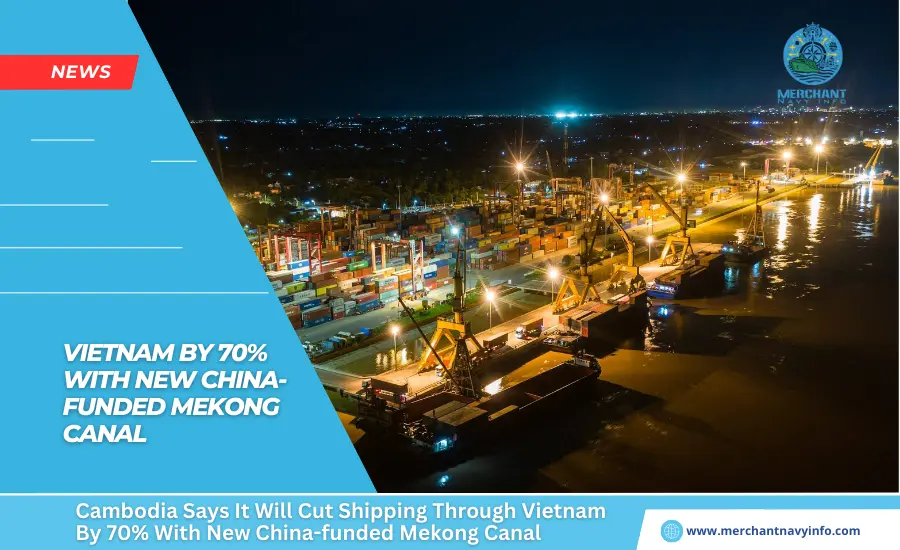
Cambodia plans to cut shipping through Vietnam ports by 70%. This is the result of a $1.7 billion China-funded renovation of a canal connecting the Mekong River basin. To the Cambodian coast, the country’s deputy prime minister told Reuters.
The project is expected to be completed by 2028 and could reignite tensions between Cambodia and Vietnam. Which are close partners but have often clashed. Conservationists and Vietnamese authorities expressed concern about possible damage to Vietnam’s. Already fragile Mekong Delta, a vast rice-growing region that is home to millions of people downstream.
However, Mr. Saint-Chantre said the canal would also be used for land irrigation. And fishing but said the diverted water was “a drop in the ocean.”
He said barges and ships carrying textiles and raw materials to and also from Phnom Penh. Would have a shorter route through the canal to reach the sea, which would reduce greenhouse gas emissions.
Reuters Graphic Cambodia has notified the Mekong River Commission (MRC). An intergovernmental organization aimed at jointly managing the basin. But it has no intention of consulting other countries in the region on the project, he said. He said Cambodia would provide additional information to the MRC upon request but was not legally required to do so.
The MRC told Reuters that Cambodia had not communicated the canal’s feasibility study. Despite repeated requests and his two formal letters in August and October. Vietnam’s Ministry of Foreign Affairs spokesperson said in a statement that Cambodia hopes to share information. And also coordinate with Hanoi to assess the project’s impact.
Risk of Rice Issue?
Currently, about 33% of cargo to and from Cambodia uses Vietnam’s ports. For global trade via the Mekong River,. Said Saint Chantre, adding that with the canal’s expansion, he expects to increase this share. He pointed out that the goal is to increase it to 10%. A 70% decrease from current shipments would be outrageous.
But the canal’s limited capacity “calls into question its economic viability,” said former U.S. Ambassador to Vietnam and influential advocacy group U.S.-ASEAN. Ted Osius, current president of the Business Council.
The improved 180 km (11 miles) canal will be 100 meters (328 feet) wide and up to 5.4 meters (18 feet) deep, allowing access to barges and ships of up to 3,000 tons, Sun Chansol said.
“This project has minimal environmental impact,” he said, adding that the project would release up to 5 cubic meters (m3) of water per second, compared to 8,000 cubic meters (m3) per second in the Mekong River. He pointed out that this would result in the release of “The canal is the size of a straw,” he pointed out. However, concerns remain, particularly in Vietnam.
Supply Chain
Nguyen Hung, a supply chain expert at RMIT Vietnam University, said: “This project could lead to the displacement of existing populations, loss of agricultural land, and reduction of wetlands.” I echoed your concerns. Brian Eyler, sustainability program director at the Stimson Center, a U.S. think tank, said the canal would “reduce water available for industrial rice production in Vietnam.”
Mr Eyler said the project required consultation with other partners under the Mekong River Commission’s regulations, as the Bassac River, where water would be diverted, is a tributary of the Mekong River and not a tributary. However, in the case of Sun Chanthol, consultation with partners is not required as the project only affects tributaries of the Mekong River, including the Bassac River.
The canal “will benefit 1.6 million Cambodians living along the canal” thanks to improved agricultural irrigation, said Saint Chantre, and the impact on water resources in the Mekong basin will be monitored. He added that it would be done.
China Road and Bridge Corporation
A major Chinese construction company, will develop the canal under an agreement with the Cambodian government and bear all its costs, adding that the company will receive multiple payments in return. He said he would receive payment. Ten years of concessions. “Whether it’s 30 years, 40 years, 50 years, that will be discussed during the negotiations,” he said.
CRBC did not respond to requests for comment. Sun Chanthol said speculation that the canal could be used by China for military purposes was “completely untrue. “Our constitution does not allow foreign military personnel to reside in the country,” he said. Western diplomats based in Vietnam also called the warnings of Vietnamese scientists about the security risks to Vietnam due to the limited depth of the canal and the size of the locks “somewhat exaggerated.” Rejected.









